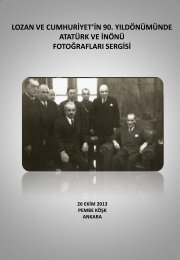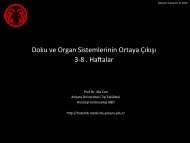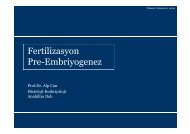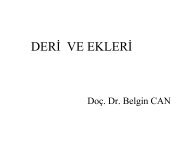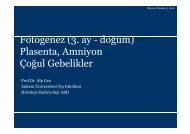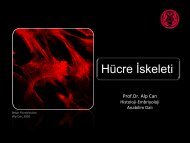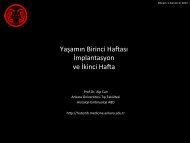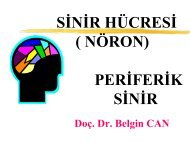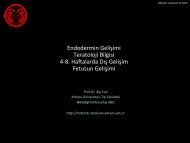dosya indir - ankaratiphastaneleri
dosya indir - ankaratiphastaneleri
dosya indir - ankaratiphastaneleri
You also want an ePaper? Increase the reach of your titles
YUMPU automatically turns print PDFs into web optimized ePapers that Google loves.
S132<br />
D. Blarent ve ark.<br />
325. Paterson SJ, Byrne PJ, Molesky MG, Seal RF, Finucane BT. Neonatal<br />
resuscitation using the laryngeal mask airway. Anesthesiology<br />
1994; 80:1248-53.<br />
326. Trevisanuto D, Ferrarese P, Zanardo V, Chiandetti L. Laryngeal<br />
mask airway in neonatal resuscitation: a survey of current practice<br />
and perceived role by anaesthesiologists and pOEDiatricians.<br />
Resuscitation 2004; 60:291-6.<br />
327. Hansen TG, Joensen H, Henneberg SW, Hole P. Laryngeal<br />
mask airway guided tracheal intubation in a neonate with the<br />
Pierre Robin syndrome. Acta Anaesthesiol Scand 1995;<br />
39:129-31.<br />
328. Osses H, Poblete M, Asenjo F. Laryngeal mask for difficult intubation<br />
in children. POEDiatr Anaesth 1999; 9:399-401.<br />
329. Stocks RM, Egerman R, Thompson JW, Peery M. Airway management<br />
of the severely retrognathic child: use of the laryngeal<br />
mask airway. Ear Nose Throat J 2002; 81:223-6.<br />
330. Palme-Kilander C, Tunell R, Chiwei Y. Pulmonary gas exchange<br />
immediately after birth in spontaneously breathing infants.<br />
Arch Dis Child 1993; 68:6-10.<br />
331. Aziz HF, Martin JB, Moore JJ. The pediatric disposable end-tidal<br />
carbon dioxide detector role in endotracheal intubation in<br />
newborns. J Perinatol 1999; 19:110-3.<br />
332. Bhende MS, LaCovey D. A note of caution about the continuous<br />
use of colorimetric end-tidal CO2 detectors in children. Pediatrics<br />
1995; 95:800-1.<br />
333. Repetto JE, Donohue P-CP, Baker SF, Kelly L, Nogee LM. Use<br />
of capnography in the delivery room for assessment of endotracheal<br />
tube placement. J Perinatol 2001; 21:284-7.<br />
334. Roberts WA, Maniscalco WM, Cohen AR, Litman RS, Chhibber<br />
A. The use of capnography for recognition of esophageal intubation<br />
in the neonatal intensive care unit. Pediatr Pulmonol<br />
1995; 19:262-8.<br />
335. Berg RA, Otto CW, Kern KB, et al. A randomized, blinded trial<br />
of high-dose epinephrine versus standard-dose epinephrine<br />
in a swine model of pediatric asphyxial cardiac arrest. Crit Care<br />
Med 1996; 24:1695-700.<br />
336. Burchfield DJ, Preziosi MP, Lucas VW, Fan J. Effects of graded<br />
doses of epinephrine during asphxia-induced bradycardia in<br />
newborn lambs. Resuscitation 1993; 25:235-44.<br />
337. Ralston SH, Voorhees WD, Babbs CF. Intrapulmonary epinephrine<br />
during prolonged cardiopulmonary resuscitation: improved<br />
regional blood flow and resuscitation in dogs. Ann Emerg<br />
Med 1984; 13:79-86.<br />
338. Ralston SH, Tacker WA, Showen L, Carter A, Babbs CF. Endotracheal<br />
versus intravenous epinephrine during electromechanical<br />
dissociation with CPR in dogs. Ann Emerg Med 1985;<br />
14:1044-8.<br />
339. Redding JS, Asuncion JS, Pearson JW. Effective routes of drug<br />
administration during cardiac arrest. Anesth Analg 1967;<br />
46:253-8.<br />
340. Schwab KO, von Stockhausen HB. Plasma catecholamines after<br />
endotracheal administration of adrenaline during postnatal resuscitation.<br />
Arch Dis Child Fetal Neonatal Ed 1994; 70:F213-7.<br />
341. Brambrink AM, Ichord RN, Martin LJ, Koehler RC, Traystman RJ.<br />
Poor outcome after hypoxia-ischemia in newborns is associated<br />
with physiological abnormalities during early recovery.<br />
Possible relevance to secondary brain injury after head trauma<br />
in infants. Exp Toxicol Pathol 1999; 51:151-62.<br />
342. Vannucci RC, Vannucci SJ. Cerebral carbohydrate metabolism<br />
during hypoglycemia and anoxia in newborn rats. Ann Neurol<br />
1978; 4:73-9.<br />
343. Yager JY, Heitjan DF, Towfighi J, Vannucci RC. Effect of insulininduced<br />
and fasting hypoglycemia on perinatal hypoxic-ischemic<br />
brain damage. Pediatr Res 1992; 31:138-42.<br />
344. Salhab WA, Wyckoff MH, Laptook AR, Perlman JM. Initial<br />
hypoglycemia and neonatal brain injury in term infants with<br />
severe fetal acidemia. Pediatrics 2004; 114:361-6.<br />
345. Kent TA, Soukup VM, Fabian RH. Heterogeneity affecting outcome<br />
from acute stroke therapy: making reperfusion worse.<br />
Stroke 2001; 32:2318-27.<br />
346. Eicher DJ, Wagner CL, Katikaneni LP, et al. Moderate hypothermia<br />
in neonatal encephalopathy: efficacy outcomes. Pediatr<br />
Neurol 2005; 32:11-7.<br />
347. Thoresen M, Whitelaw A. Cardiovascular changes during mild<br />
therapeutic hypothermia and rewarming in infants with hypoxic-ischemic<br />
encephalopathy. Pediatrics 2000; 106:92-9.<br />
348. Shankaran S, Laptook A, Wright LL, et al. Whole-body hypothermia<br />
for neonatal encephalopathy: animal observations as a<br />
basis for a randomized, controlled pilot study in term infants.<br />
Pediatrics 2002; 110:377-85.<br />
349. Leeuw R, Cuttini M, Nadai M, et al. Treatment choices for extremely<br />
preterm infants: an international perspective. J Pediatr<br />
2000; 137:608-16.<br />
350. Lee SK, Penner PL, Cox M. Comparison of the attitudes of health<br />
care professionals and parents toward active treatment of<br />
very low birth weight infants. Pediatrics 1991;88:110-4.<br />
351. Kopelman LM, Irons TG, Kopelman AE, Neunatologists judge<br />
the “Baby Doe” regulations. N Engl J Med 1988; 318:677-83.<br />
352. Sanders MR, Donohue PK, Oberdorf MA, Rosenkrantz TS, Allen<br />
MC. Perceptions of the limit of viability: neonatomogists'<br />
attitudes toward extremely preterm infants. J Perinatol 1995;<br />
15:494-502.<br />
353. Draper ES, Manktelow B, Field DJ, James D. Tables for predicting<br />
survival for preterm births are updated. BMJ 2003;<br />
327:872.<br />
354. Jain L, Fere C, Vidyasagar D, Nath S, Sheftel D. Cardiopulmonary<br />
resuscitation of apparently stillborn infants: survival and<br />
long-term outcome. J Pediatr 1991; 18:778-82.<br />
355. Haddad B, Mercer BM, Livingston JC, Talati A, Sibai<br />
BM. Outcomo after successful resuscitation of babies born<br />
with apgar scores of 0 at both 1 and 5 minutes. Am J Obstet<br />
Gynecol 2000; 182:1210-4.



